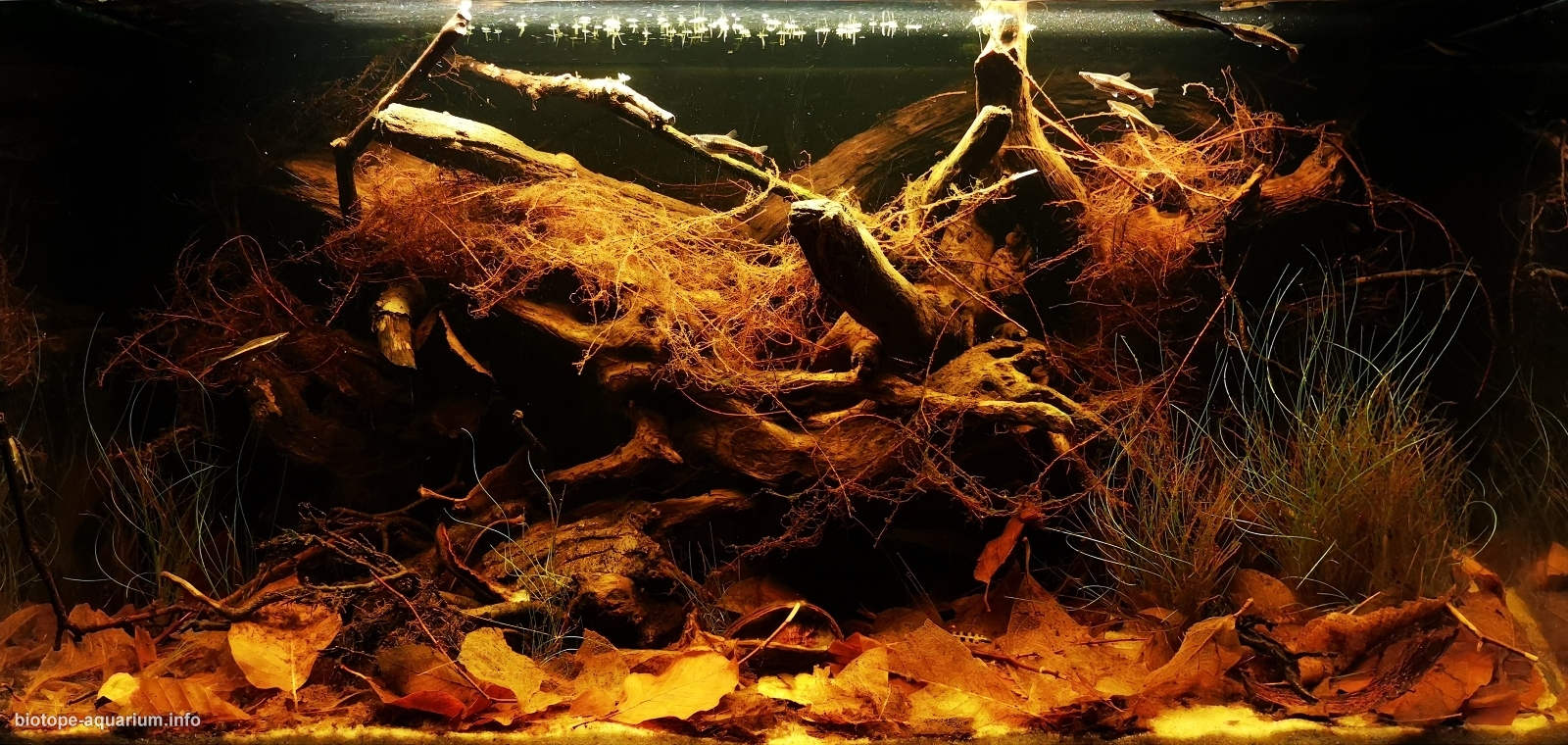Forest stream, Santa Isabel do Rio Negro, Brasil
_th place in Biotope Aquarium Design Contest 2020

Volume: 119 l
Dimensions: 80x35x40 cm
List of fishes: Dicrossus filamentosus, Nannostomus eques, otocinclus sp.
List of plants: Eleocharis acicularis
Description of decorations: Driftwood similar in shape and appearance to natural habitats. Fine sand of cream color, fraction 0-1mm. Dry leaves. Capillary roots that form a dense tangle.
Description of equipment: External filter JBL Cristal profi e700, lighting Atman AT-70A 1x20w
Water parameters: Temperature is 26 ° C, pH 5.5, conductivity 130 μS, ppm 66, GH 3, KH 1, NO 2 0, NO 3 less than 10
Additional info: I make water for the aquarium using reverse osmosis with an ionizer. I adjust the pH with phosphoric acid. I change the water once every 14 days about 1/2 volume. When replacing, I clean the glass and vacuum the unfolded sheets and replace them with new ones. I do sludge removal once every 2 months. Oxygenation and movement of the water is ensured by the outlet ramp from the filter located at the level.
INFORMATION ABOUT BIOTOPE:
Description of the area surrounding the biotope: The Rio Negro around Santa Isabel do Rio Negro has a wide stream with lots of islands, lagoons and a tangle of forest streams. The abundant tree species around the habitat include Virola elongata, Eschweilera longipes, E. pachysepala, Pithecellobium amplissimum. Especially during the rainy season from April to October, the river floods a huge area and can reach up to 30 km in width. Near Carvoeria, the Branco River joins the Rio Negro, and the river temporarily forms the border between the state of Roraima and the state of Amazonas in Brazil. The river then turns southeast and heads for the largest city on its course, Manaus.
Description of the underwater landscape of the biotope: The river flows through the rainforest and therefore contains a lot of driftwood, leaves and other organic material from the decomposition of wood, leaves and plants. The bottom is made of fine cream-colored sand, in places with a large layer of sediment and fallen leaves. It is the tangle of roots and infested wood that is an ideal refuge for all kinds of aquatic animals.
Description of the parameters of the habitat: The water is very dark, soft and acidic, which is caused by humic acids and humins leached from the forest substrate and organic material that has fallen into the water. In forest streams and lagoons outside the rainy season, it is the color of strong tea, but it is still transparent. During the rainy season, the river carries a large amount of washed-out soil and becomes cloudy. The temperature depending on the season varies between 23-26 ° C, pH 2.9-4.2, the total hardness is not greater than 1GH and the carbonate hardness is up to 0.5KH.
List of fishes and invertebrates occurring in the nature biotope: Paracheirodon innesi, Hemigrammus bleheri, apistogramma hipollytae, apistogramma pertensis, apistogramma gibbiceps, nannostomus trifasciatus, nannostomus eques, paracheirodon axelrodi, ancistrus dolichopterus, pterophyllum sp., Dicrossus faruicanus.
List of plants found in the nature biotope: Eleocharis acicularis, echinodorus tenellus, echinodorus horizontalis, cabomba, eichhornia crassipes, salvinia oblongifolia, limnobium laevigatum.
Threats to the ecology: The ecological problem, especially on the lower rivers, is the same as in most of the Amazon and it is continuous deforestation due to agricultural and mining interests. Specifically on the Rio Negro there could be a problem with water contamination from Seis Lagos, near San Gabriel where should mining bans in this area be breached. This would endanger a large number of species that live here.
Sources of information:
